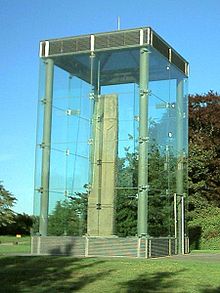Sueno's Stone
The Suenostein ( English Sueno’s Stone ) is a 7 m high and approx. 1.35 m wide flat stone stele ( cross stone ) made of red sandstone and comes from the era of the Picts . The stone stands at a crossroads in the north-east of the Scottish town of Forres , and has been in a bulletproof glass housing since the 1990s to protect against all types of vandalism and erosion .
The Scotsman Alexander Gordon described the stone in his 1726 work Itinerarium Septentrionale (Latin: Northern route or description) and added that Lady Anne Countess of Murray straightened the stone at her own expense and with a stable foundation because it was in danger of falling have supported. The engravings on the eastern stone surface depict battle and war scenes, while a Celtic cross is incorporated on the western side . The narrow sides are decorated with ornaments. In the course of its existence, measured by the condition of the surface, the stone must have lain in the ground for a long time. The name "Sueno" (Sven (d), Svein) is intended to refer to the Danish king Sven I. Gabelbart (Danish Svend I Tveskæg, nor. Svein I Tveskjegg or Tjugeskjegg), but was not created in the context of this.
According to current knowledge, the war or battle scenes on the stone, which have given rise to much speculation, represent a previously unknown victory of the Picts over another tribe from Eastern Scotland. Older theories saw the stone engravings as a victory of Máel Coluim mac Cináeda (Malcolms II., King of Scotland from 1005 to 1034) against invading Danes or Normans or the defeat and death of Dub mac Maíl Coluim 966/967.
Just a few kilometers from the Suenostein is the similar cross-slab from Altyre House .
literature
- Alexander Gordon : Itinerarium Septentrionale , London 1726, part II, p. 158f. with plate 56
- The Suenostein in Scotland . In: Das Pfennig-Magazin , Vol. 3, Leipzig: Brockhaus 1835, pp. 413f.
Web links
- high resolution black and white photos of both sides of the stone
- Description in English and picture
Coordinates: 57 ° 36 ′ 56.3 " N , 3 ° 35 ′ 51.6" W.

